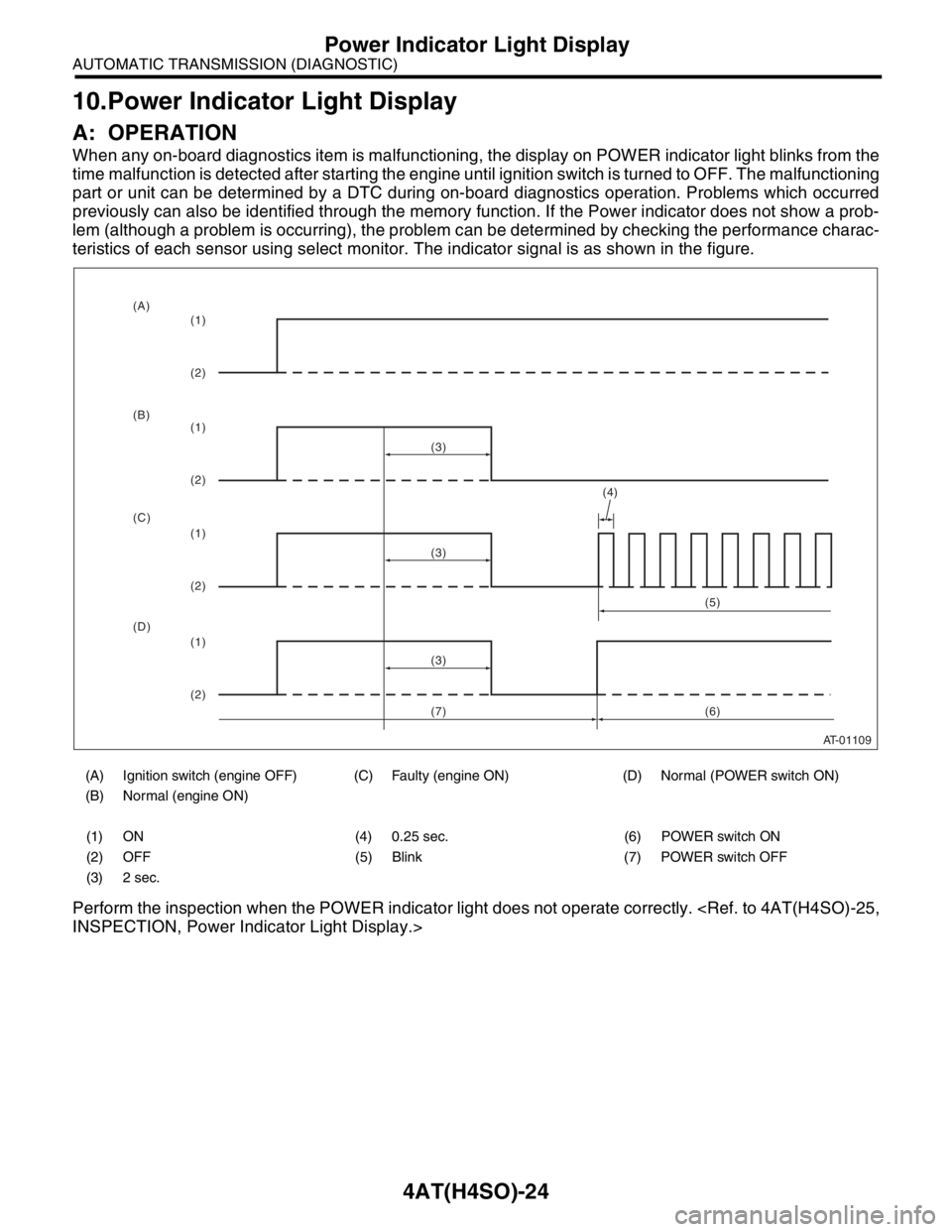2004 SUBARU FORESTER check engine light
[x] Cancel search: check engine lightPage 2472 of 2870

4AT(H4SO)-13
AUTOMATIC TRANSMISSION (DIAGNOSTIC)
Transmission Control Module (TCM) I/O Signal
Inhibitor
switch“2” range
switchB55 6Select lever in “2” range Less than 1
—
Select lever in any other
than “2” rangeMore than 8
“1” range
switchB55 7Select lever in “1” range Less than 1
—
Select lever in any other
than “1” rangeMore than 8
Brake switch B55 12Brake pedal depressed More than 10.5
—
Brake pedal released Less than 1
Kick-down switch B55 11Throttle fully opened Less than 1
—
Throttle fully closed More than 6.5
AT OIL TEMP warning light B56 10Light ON Less than 1
—
Light OFF More than 9
Throttle position sensor B54 3Throttle fully closed 0.2 — 1.0
—
Throttle fully open 4.2 — 4.7
Throttle position sensor
power supplyB54 2Ignition switch ON (with
engine OFF)4.8 — 5.3 —
ATF temperature sensor B54 11ATF temperature 20°C
(68°F)1.6 — 2.0 2.1 k — 2.9 k
ATF temperature 80°C
(176°F)0.4 — 0.9 275 — 375
Rear vehicle speed sensor B55 24Vehicle stopped 0
450 — 650
Vehicle speed at least 20
km/h (12 MPH)More than 1 (AC range)
Front vehicle speed sensor B55 18Vehicle stopped 0
450 — 650
Vehicle speed at least 20
km/h (12 MPH)More than 1 (AC range)
Torque converter turbine
speed sensorB55 8Engine idling after warm-
up (D range)0
450 — 650
Engine idling after warm-
up (N range)More than 1 (AC range)
Vehicle speed output signal B56 17Vehicle speed at most 10
km/h (6 MPH)Less than 1 ←
→ More than 4—
Engine speed signal B55 17Ignition switch ON (with
engine OFF)More than 10.5
—
Ignition switch ON (with
engine ON)8 — 11
Cruise set signal B55 22When cruise control is set
(SET lamp ON)Less than 1
—
When cruise control is not
set (SET lamp OFF)More than 6.5
Torque control signal 1 B56 5Ignition switch ON (with
engine ON)More than 4 —
Torque control signal 2 B56 14Ignition switch ON (with
engine ON)More than 4 —
Torque control cut signal B55 10Ignition switch ON
(After engine is warmed-up)8—
Intake manifold pressure
signalB54 1 Engine idling after warm-up 0.4 — 1.6 —
Shift solenoid 1 B54 221st or 4th gear More than 9
10 — 16
2nd or 3rd gear Less than 1
Shift solenoid 2 B54 51st or 2nd gear More than 9
10 — 16
3rd or 4th gear Less than 1 Check with ignition switch ON.
ContentConnector
No.Terminal No. Measuring conditions Voltage (V)Resistance
to chassis
ground (Ω)
Page 2473 of 2870

4AT(H4SO)-14
AUTOMATIC TRANSMISSION (DIAGNOSTIC)
Transmission Control Module (TCM) I/O Signal
Line pressure duty solenoid B54 9Ignition switch ON (with
engine OFF)
Throttle fully closed after
war m-up1.5 — 4.0
2.0 — 4.5
Ignition switch ON (with
engine OFF)
Throttle fully open after
war m-upLess than 0.5
Lock-up duty solenoid B54 7When lock up occurs More than 8.5
10 — 17
When lock up is released Less than 0.5
Transfer duty solenoid B54 6Fuse on FWD switch Less than 0.5
10 — 17 Fuse removed from FWD
switch (with throttle fully
open and with select lever
in 1st gear)More than 8.5
2-4 brake duty solenoid B54 18Throttle fully closed (with
engine OFF) after warm-up1.5 — 5.0
2.0 — 4.5
Throttle fully open (with
engine OFF) after warm-upLess than 0.5
2-4 brake timing solenoid B54 161st gear Less than 1
10 — 16
3rd gear More than 9
Low clutch timing solenoid B54 152nd gear Less than 1
10 — 16
4th gear More than 9
HOLD switch B55 16HOLD switch ON Less than 1 —
HOLD switch OFF More than 8 —
POWER switch B55 23POWER switch ON Less than 1 —
POWER switch OFF More than 10 —
POWER indicator light B56 11Light ON Less than 1 —
Light OFF More than 9 —
FWD switch B55 20Fuse removed 6 — 9.1 —
Fuse installed Less than 1 —
FWD indicator light B56 2Fused on FWD switch Less than 1 —
Fuse removed from FWD
switchMore than 9 —
ABS signal B55 21ABS switch ON Less than 1 —
ABS switch OFF 6.5 — 15 —
Sensor ground line 1 B54 20 — 0 Less than 1
Sensor ground line 2 B55 9 — 0 Less than 1
System ground lineB56 19
— 0 Less than 1
B54 21
Sensor ground line 3 B54 10 — 0 Less than 1
Sensor ground line 4 B54 19 — 0 Less than 1
AT diagnosis signal B56 21 Ignition switch ONLess than 1 ←
→ More than 4—
Data link signal (Subaru
Select Monitor)B56 15 — — —Check with ignition switch ON.
ContentConnector
No.Terminal No. Measuring conditions Voltage (V)Resistance
to chassis
ground (Ω)
Page 2477 of 2870
![SUBARU FORESTER 2004 Service Repair Manual 4AT(H4SO)-18
AUTOMATIC TRANSMISSION (DIAGNOSTIC)
Subaru Select Monitor
2. READ CURRENT DATA
1) On the «Main Menu» display screen, select the {Each System Check} and press the [YES] key.
2) On the « SUBARU FORESTER 2004 Service Repair Manual 4AT(H4SO)-18
AUTOMATIC TRANSMISSION (DIAGNOSTIC)
Subaru Select Monitor
2. READ CURRENT DATA
1) On the «Main Menu» display screen, select the {Each System Check} and press the [YES] key.
2) On the «](/manual-img/17/57426/w960_57426-2476.png)
4AT(H4SO)-18
AUTOMATIC TRANSMISSION (DIAGNOSTIC)
Subaru Select Monitor
2. READ CURRENT DATA
1) On the «Main Menu» display screen, select the {Each System Check} and press the [YES] key.
2) On the «System Selection Menu» display screen, select the {Transmission Control System} and press the
[YES] key.
3) Press the [YES] key after the information of transmission type is displayed.
4) On the «Transmission Diagnosis» display screen, select the {Current Data Display & Save} and press the
[YES] key.
5) On the «Data Display Menu» display screen, select the {Data Display} and press the [YES] key.
6) Using the scroll key, move the display screen up or down until desired data is shown.
A list of the support data is shown in the following table.
NOTE:
For detailed operation procedure, refer to the SUBARU SELECT MONITOR OPERATION MANUAL.
Contents Display Unit of measure
Battery voltage Battery Voltage V
Rear vehicle speed sensor signal Rear Wheel Speed km/h or MPH
Front vehicle speed sensor signal Front Wheel Speed km/h or MPH
Engine speed signal Engine Speed rpm
Automatic transmission fluid temperature signal ATF Temp.°C or °F
Throttle position signal Throttle Sensor Voltage V
Gear position Gear Position —
Line pressure control duty ratio Line Pressure Duty Ratio %
Lock up clutch control duty ratio Lock Up Duty Ratio %
Transfer clutch control duty ratio (AWD model) Transfer Duty Ratio %
Power supply for throttle position sensor Throttle Sensor Power V
Torque converter turbine speed signal Turbine Revolution Speed rpm
2-4 brake timing pressure control duty ratio Brake Clutch Duty Ratio %
Intake manifold pressure sensor voltage Mani. Pressure Voltage V
FWD switch signal FWD Switch ON or OFF
Stop light switch signal Stop Light Switch ON or OFF
Anti lock brake system signal ABS Signal ON or OFF
Cruise control system signal Cruise Control Signal ON or OFF
Parking range signal P Range Signal ON or OFF
Neutral range signal N Range Signal ON or OFF
Reverse range signal R Range Signal ON or OFF
Drive range signal D Range Signal ON or OFF
3rd range signal 3rd Range Signal ON or OFF
2nd range signal 2nd Range Signal ON or OFF
1st range signal 1st Range Signal ON or OFF
Shift control solenoid A Shift Solenoid #1 ON or OFF
Shift control solenoid B Shift Solenoid #2 ON or OFF
Torque control output signal #1 Torque Control Signal 1 ON or OFF
Torque control output signal #2 Torque Control Signal 2 ON or OFF
Torque control cut signal Torque Control Cut Sig. ON or OFF
2-4 brake timing control solenoid valve 2-4 Brake Timing Sol. ON or OFF
Low clutch timing control solenoid valve Low Clutch Timing Sol. ON or OFF
Automatic transmission diagnosis indicator lamp Diagnosis Lamp ON or OFF
Power mode switch signal Power Mode Switch ON or OFF
Hold mode switch signal Hold Mode Switch ON or OFF
Kick down switch signal Kick Down Switch ON or OFF
Automatic transmission fluid temperature lamp ATF Temperature Lamp ON or OFF
Page 2479 of 2870

4AT(H4SO)-20
AUTOMATIC TRANSMISSION (DIAGNOSTIC)
Read Diagnostic Trouble Code (DTC)
7. Read Diagnostic Trouble Code (DTC)
A: OPERATION
1. WITHOUT SUBARU SELECT MONITOR
Step Check Yes No
1 PERFORM READ DTC.
1) Warm-up the engine.
2) Turn the ignition switch to OFF.
3) Turn the ignition switch to ON.
4) Start the engine.
5) Drive the vehicle at speeds greater than 20
km/h (12 MPH).
6) Stop the vehicle.
7) The brake pedal depressed and move
select lever to 1 range.
8) Turn the ignition switch to OFF.
9) Turn the ignition switch to ON.
10)Move the select lever “2” range.
11)Move the select lever “1” range.
12)Move the select lever “2” range.
13)Move the select lever “3” range.
14)Move the select lever “D” range.Does the POWER indicator
light blink at 4 Hz intervals?
NOTE: Blinks every 0.125 (1/8)
seconds (until the ignition
switch is turned OFF).Go to step 2.Repair the power
supply and ground
circuit.
CHECK POWER
SUPPLY AND
GROUND LINE,
INSPECTION,
Power Indicator
Light Display.>
2 CHECK POWER INDICATOR LIGHT.Does the POWER indicator
light blink at 2 Hz intervals?
NOTE: Blinks every 0.25 (1/4)
seconds (until ignition switch is
turned to OFF).The AT system is
normal.Go to step 3.
3 CHECK POWER INDICATOR LIGHT.Is the DTC outputted by the
blink of POWER indicator
light?Inspect the prob-
lem correspond-
ing with DTC.
N
OTE:
Record all DTCs.Go to step 4.
4 CHECK POWER INDICATOR LIGHT.Does the POWER indicator
light remain illuminated?Repair the
POWER indicator
light circuit
INSPECTION,
Power Indicator
Light Display.>, or
Inspect inhibitor
switch, wiring,
TCM, etc.Calling up the DTC
again.
Page 2483 of 2870

4AT(H4SO)-24
AUTOMATIC TRANSMISSION (DIAGNOSTIC)
Power Indicator Light Display
10.Power Indicator Light Display
A: OPERATION
When any on-board diagnostics item is malfunctioning, the display on POWER indicator light blinks from the
time malfunction is detected after starting the engine until ignition switch is turned to OFF. The malfunctioning
part or unit can be determined by a DTC during on-board diagnostics operation. Problems which occurred
previously can also be identified through the memory function. If the Power indicator does not show a prob-
lem (although a problem is occurring), the problem can be determined by checking the performance charac-
teristics of each sensor using select monitor. The indicator signal is as shown in the figure.
Perform the inspection when the POWER indicator light does not operate correctly.
(A) Ignition switch (engine OFF) (C) Faulty (engine ON) (D) Normal (POWER switch ON)
(B) Normal (engine ON)
(1) ON (4) 0.25 sec. (6) POWER switch ON
(2) OFF (5) Blink (7) POWER switch OFF
(3) 2 sec.
AT-01109
(4)
(3)
(1)
(2)
(1)
(2)
(1)
(2)
(1)
(2)(3)
(3)(5)
(6) (A)
(B)
(C)
(D)
(7)
Page 2487 of 2870

4AT(H4SO)-28
AUTOMATIC TRANSMISSION (DIAGNOSTIC)
Power Indicator Light Display
Step Check Yes No
1 CHECK POWER INDICATOR LIGHT.
Turn the ignition switch to ON (engine OFF).Does the POWER indicator
light illuminate?Go to step 3.Go to step 2.
2 CHECK POWER INDICATOR LIGHT.
1) Turn the ignition switch to OFF.
2) Remove the combination meter.
3) Remove the POWER indicator light bulb
from combination meter.Is the POWER indicator light
bulb OK?Go to step 4.Replace the
POWER indicator
light bulb.
3 CHECK POWER INDICATOR LIGHT.
Perform “Read Diagnostic Trouble Code
(DTC)”.
light blink?A temporary poor
contact of the con-
nector or harness
may be the cause.
Repair the har-
ness or connector
in TCM, inhibitor
switch and combi-
nation meter.Go to step 9.
4 CHECK FUSE (No. 14).
Remove the fuse (No. 14).Is the fuse (No. 14) blown out? Replace the fuse
(No. 14). If
replaced fuse (No.
14) is blown out
easily, repair short
circuit in harness
between fuse (No.
14) and combina-
tion meter.Go to step 5.
5 CHECK HARNESS CONNECTOR BETWEEN
COMBINATION METER AND IGNITION
SWITCH.
1) Turn the ignition switch to ON (engine
OFF).
2) Measure the voltage between combination
meter connector and chassis ground.
Connector & terminal
(i10) No. 9 (+) — Chassis ground (
−):Is the voltage more than 9 V? Go to step 6.Repair the open
circuit in harness
between combina-
tion meter and bat-
tery.
6 CHECK COMBINATION METER.
Measure the voltage between combination
meter connector and chassis ground.
Connector & terminal
(i11) No. 2 (+) — Chassis ground (
−):Is the voltage less than 9 V? Repair the combi-
nation meter.
Meter Assembly.>Go to step 7.
7 CHECK OPEN CIRCUIT OF HARNESS.
1) Turn the ignition switch to OFF.
2) Disconnect the connector from combination
meter connector.
3) Measure the resistance of harness
between combination meter.
Connector & terminal
(B56) No. 11 — (i11) No. 2:Is the resistance less than 1
Ω?Go to step 8.Repair the open
circuit in harness
between TCM and
combination
meter, and poor
contact in cou-
pling connector.
8 CHECK INPUT SIGNAL FOR TCM.
1) Connect the connector to TCM and combi-
nation meter.
2) Turn the ignition switch to ON (engine
OFF).
3) Measure the voltage between TCM con-
nector and chassis ground.
Connector & terminal
(B56) No. 11 (+) — Chassis ground (
−):Is the voltage less than 1 V? Even if the
POWER indicator
lights up, the cir-
cuit has returned
to a normal condi-
tion at this time. A
temporary poor
contact of the con-
nector or harness
may be the cause.
Repair the har-
ness or connector
in TCM.Replace the TCM.
trol Module
(TCM).>
Page 2490 of 2870

4AT(H4SO)-31
AUTOMATIC TRANSMISSION (DIAGNOSTIC)
Power Indicator Light Display
Step Check Yes No
1 CHECK BATTERY TERMINAL.
Turn the ignition switch to OFF.Is there poor contact at battery
terminal?Repair or tighten
the battery termi-
nal.Go to step 2.
2 CHECK POWER SUPPLY OF TCM.
1) Disconnect the connector from TCM.
2) Turn the ignition switch to ON.
3) Measure the voltage between TCM con-
nector and chassis ground.
Connector & terminal
(B56) No. 1 (+) — Chassis ground (
−):Is the voltage 10 — 13 V? Go to step 4.Go to step 3.
3 CHECK FUSE (NO. 4).
Remove the fuse (No. 4).Is the fuse (No. 4) blown out? Replace the fuse
(No. 4). If replaced
fuse (No. 4) has
blown out easily,
repair short circuit
in harness
between fuse (No.
4) and TCM.Repair the open
circuit in harness
between fuse (No.
4) and TCM, or
fuse (No. 4) and
battery, and poor
contact in cou-
pling connector.
4 CHECK IGNITION POWER SUPPLY CIR-
CUIT.
1) Turn the ignition switch to ON (engine
OFF).
2) Measure the ignition power supply voltage
between TCM connector and chassis ground.
Connector & terminal
(B54) No. 23 (+) — Chassis ground (–):
(B54) No. 24 (+) — Chassis ground (–):Is the voltage 10 — 13 V? Go to step 6.Go to step 5.
5 CHECK FUSE (NO. 11).
Remove the fuse (No. 11).Is the fuse (No. 11) blown out? Replace the fuse
(No. 11). If
replaced fuse (No.
11) has blown out
easily, repair short
circuit in harness
between fuse (No.
11) and TCM.Repair the open
circuit in harness
between fuse (No.
11) and TCM, or
fuse (No. 11) and
battery, and poor
contact in cou-
pling connector.
6 CHECK HARNESS CONNECTOR BETWEEN
TCM AND TRANSMISSION.
1) Turn the ignition switch to OFF.
2) Disconnect the connector from TCM and
transmission.
3) Measure the resistance of harness
between TCM and transmission connector.
Connector & terminal
(B56) No. 19 — (B11) No. 16:
(B54) No. 21 — (B11) No. 16:Is the resistance less than 1
Ω?Go to step 7.Repair the open
circuit in harness
between TCM,
transmission har-
ness connector,
and poor contact
in coupling con-
nector.
7 CHECK HARNESS CONNECTOR BETWEEN
TRANSMISSION AND TRANSMISSION
GROUND.
Measure the resistance of harness between
transmission and transmission ground.
Connector & terminal
(T4) No. 16 — Transmission ground:Is the resistance less than 1
Ω?Go to step 8.Repair the open
circuit in harness
between transmis-
sion and transmis-
sion ground.
8 CHECK POOR CONTACT IN CONNECTORS.Is there poor contact in control
module power supply, ground
line and data link connector?Repair the con-
nector.Replace the TCM.
trol Module
(TCM).>
Page 2496 of 2870

4AT(H4SO)-37
AUTOMATIC TRANSMISSION (DIAGNOSTIC)
Diagnostic Procedure with Diagnostic Trouble Code (DTC)
Step Check Yes No
1 CHECK HARNESS CONNECTOR BETWEEN
TCM AND ECM.
1) Turn the ignition switch to OFF.
2) Disconnect the connectors from TCM and
ECM.
3) Measure the resistance of harness
between TCM and ECM connector.
Connector & terminal
(B55) No. 17 — (B134) No. 10:Is the resistance less than 1
Ω?Go to step 2.Repair the open
circuit in harness
between TCM and
ECM connector.
2 CHECK HARNESS CONNECTOR BETWEEN
TCM AND ECM.
Measure the resistance of harness between
TCM connector and chassis ground.
Connector & terminal
(B55) No. 17 — Chassis ground:Is the resistance more than 1
MΩ?Go to step 3.Repair the short
circuit in harness
between TCM and
ECM connector.
3 PREPARE SUBARU SELECT MONITOR.Do you have a Subaru Select
Monitor?Go to step 5.Go to step 4.
4 CHECK INPUT SIGNAL FOR TCM.
1) Connect the connectors to TCM and ECM.
2) Turn the ignition switch to ON (engine
OFF).
3) Measure the voltage between TCM con-
nector and chassis ground.
Connector & terminal
(B55) No. 17 (+) — Chassis ground (
−):Is the voltage more than 10.5
V?Even if the
POWER indicator
light was blinking,
the circuit has
returned to a nor-
mal condition at
this time. A tempo-
rary poor contact
of the connector or
harness may be
the cause. Repair
the harness or
connector in TCM
and ECM.Go to step 6.
5 CHECK INPUT SIGNAL FOR TCM USING
SUBARU SELECT MONITOR.
1) Connect the connectors to TCM and ECM.
2) Connect the Subaru Select Monitor to data
link connector.
3) Start the engine and turn Subaru Select
Monitor switch to ON.
4) Warm-up the engine until engine coolant
temperature is above 80°C (176°F).
5) Idle the engine.
6) Read the data of engine speed using Sub-
aru Select Monitor.
Display shows the engine speed signal value
sent from ECM.Is the revolution value same as
tachometer reading shown on
combination meter?Even if the
POWER indicator
light was blinking,
the circuit has
returned to a nor-
mal condition at
this time. A tempo-
rary poor contact
of the connector or
harness may be
the cause. Repair
the harness or
connector in TCM
and ECM.Go to step 6.
6 CHECK POOR CONTACT.Is there poor contact in engine
speed signal circuit?Repair the poor
contact.Go to step 7.
7 CONFIRM DTC 11.Replace the ECM with a new
one. Does the DTC 11 appear
again, after memory has been
cleared?Replace the TCM.
trol Module
(TCM).>Replace the ECM.
Engine Control
Module (ECM).>